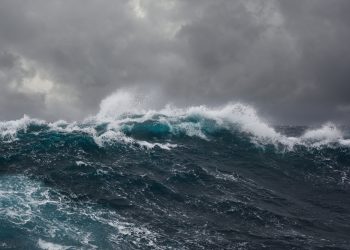The Alaska Department of Environmental Conservation informed that a marine debris cleanup barge has arrived in Anchorage for offloading. The barge spent 40 days in Prince William Sound receiving tons of debris that had washed up on the shoreline.
Marine debris is not a new problem to the state, but Alaskans have seen an uptick in this environmental hazard since the March 2011 earthquake and tsunami in Japan, which swept thousands of tons of debris into the Pacific Ocean. Significant increases of marine debris of presumed Japanese origin have since been noted on coastlines from Kodiak Island through Prince William Sound and Southeast Alaska.
Building on past efforts to remove marine debris from Alaska’s coast and using funds from a gift from the Government of Japan, the Alaska Department of Environmental Conservation (DEC) awarded a contract to the non-profit organization Gulf of Alaska Keeper to clean shorelines on Kayak and Montague Islands and dispose of the collected debris in an approved landfill facility. These locations were selected to be the focus of 2016 field operations based on the high density of marine debris accumulated in these areas, safety considerations, and overall cost effectiveness.
With the focus on removing plastic and foam debris, the Gulf of Alaska Keeper crew spent over 40 days this summer working to clean 10 miles of shoreline in Prince William Sound. Debris was placed into 1.3-cubic yard “super sacks” and slung by helicopter onto an awaiting barge, while large items such as aquaculture buoys, large nets, and plastic drums and tanks were roped into bundles and airlifted directly onto the barge.
A large ocean-capable tug and 54-feet wide by 180-feet long barge was used for the debris removal and transport portion of the project. Side walls were later added to the barge to increase the capacity by allowing sacks to be stacked higher. Approximately 1,200 “super sacks” and nearly twice that amount of bundled fishing line, nets, and buoys were transferred to the barge. The vessel and teams then departed for the North Star Terminal and Stevedore dockyard at the Port of Anchorage, arriving Thursday, July 14, 2016.
Post-offloading recycling efforts are being coordinated by Parley for the Oceans, an oceans advocacy organization which has previously partnered with the Adidas company to create an eco-friendly shoe made from recycled gillnet. Volunteer teams organized by Parley will sort debris that can be recycled or repurposed, starting on July 16 and continuing through July 26.
Recyclable materials will be shipped out of state to Parley manufacturing facilities, and repurposed debris such as intact fishing buoys will be segregated for eventual reuse by commercial fishermen or by the arts and crafts community. Non-reusable debris will be disposed of at the Anchorage landfill.
Marine debris has far-reaching effects on our environment. Polystyrene foam (also known as Styrofoam) is used in marine-related items such as buoys and floats and is also commonly found in building materials and home products that were swept away by the Japan tsunami. Foam, as well as most plastics, is not biodegradable and can remain in the environment for years. Both foam and plastics of all types can break down into smaller pieces and be mistaken for food by fish, wildlife, and seabirds. It is not easily digested so it tends to accumulate in the digestive tract of the animal who consumes it.
Ingestion can be fatal as it causes the animals to feel full and stop eating, which leads to emaciation and death from starvation. For humans, the transfer of these microplastics into the food chain and the potential bioaccumulation is a valid concern. Entanglements from lines and nets also pose dangers to sea life and terrestrial animals when it reaches the shore.
For more information on marine debris cleanup efforts in Alaska, visit:






























































